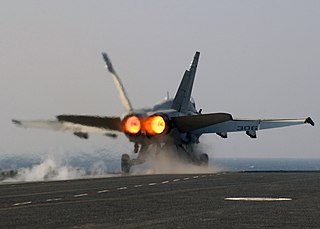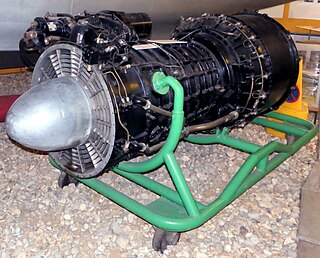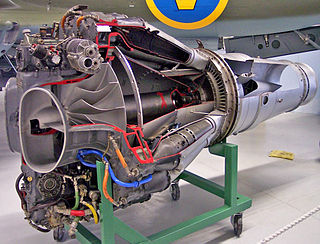Related Research Articles

An aircraft engine, often referred to as an aero engine, is the power component of an aircraft propulsion system. Aircraft using power components are referred to as powered flight. Most aircraft engines are either piston engines or gas turbines, although a few have been rocket powered and in recent years many small UAVs have used electric motors.

The BMW 003 is an early axial turbojet engine produced by BMW AG in Germany during World War II. The 003 and the Junkers Jumo 004 were the only German turbojet engines to reach production during World War II.

An afterburner is an additional combustion component used on some jet engines, mostly those on military supersonic aircraft. Its purpose is to increase thrust, usually for supersonic flight, takeoff, and combat. The afterburning process injects additional fuel into a combustor ("burner") in the jet pipe behind the turbine, "reheating" the exhaust gas. Afterburning significantly increases thrust as an alternative to using a bigger engine with its attendant weight penalty, but at the cost of increased fuel consumption which limits its use to short periods. This aircraft application of "reheat" contrasts with the meaning and implementation of "reheat" applicable to gas turbines driving electrical generators and which reduces fuel consumption.

The Rolls-Royce RB.23 Welland was Britain's first production jet engine. It entered production in 1943 for the Gloster Meteor. The name Welland is taken from the River Welland, in keeping with the Rolls-Royce policy of naming early jet engines after rivers based on the idea of continuous flow, air through the engine and water in a river.

The Metropolitan-Vickers F.2 is an early turbojet engine and the first British design to be based on an axial-flow compressor. It was an extremely advanced design for the era, using a nine-stage axial compressor, annular combustor, and a two-stage turbine.

The de Havilland Goblin, originally designated as the Halford H-1, is an early turbojet engine designed by Frank Halford and built by de Havilland. The Goblin was the second British jet engine to fly, after Whittle's Power Jets W.1, and the first to pass a type test and receive a type certificate issued for an aircraft propulsion turbine.

The Lyulka AL-7 was a turbojet designed by Arkhip Mikhailovich Lyulka and produced by his Lyulka design bureau. The engine was produced between 1954 and 1970.

The General Electric CJ805 is a jet engine which was developed by General Electric Aircraft Engines in the late 1950s. It was a civilian version of the J79 and differed only in detail. It was developed in two versions. The basic CJ805-3 was a turbojet and powered the Convair 880 airliner, and the CJ805-23 a turbofan derivative which powered the Convair 990 Coronado variant of the 880.

The Heinkel HeS 3 was the world's first operational jet engine to power an aircraft. Designed by Hans von Ohain while working at Heinkel, the engine first flew as the primary power of the Heinkel He 178, piloted by Erich Warsitz on 27 August 1939. Although successful, the engine had too little thrust to be really useful, and work started on the more powerful Heinkel HeS 8 as their first production design.

The CFE CFE738 is a small turbofan engine aimed at the business/commuter jet market manufactured by the CFE Company, and is used on the Dassault Falcon 2000.
The Avro Canada TR.4 Chinook was Canada's first turbojet engine, designed by Turbo Research and manufactured by A.V. Roe Canada Ltd. Named for the warm Chinook wind that blows in the Rocky Mountains, only three Chinooks were built and none were used operationally. After being scaled up from 2,600 lbf (12 kN) to 6,500 lbf (29 kN), it would become the Orenda.

The General Electric YJ93 turbojet engine was designed as the powerplant for both the North American XB-70 Valkyrie bomber and the North American XF-108 Rapier interceptor. The YJ93 was a single-shaft axial-flow turbojet with a variable-stator compressor and a fully variable convergent/divergent exhaust nozzle. The maximum sea-level thrust was 28,800 lbf (128 kN).

The General Electric J87 was a nuclear-powered turbojet engine designed to power the proposed WS-125 long-range bomber. The program was started in 1955 in conjunction with Convair for a joint engine/airframe proposal for the WS-125. It was one of two nuclear-powered gas turbine projects undertaken by GE, the other one being the X39 project.

The Motorlet M-701 is a Czechoslovak jet engine. It was used to power the Aero L-29 Delfín jet trainer, with about 9,250 engines built between 1961 and 1989.

The Power Jets W.1 was a British turbojet engine designed by Frank Whittle and Power Jets. The W.1 was built under contract by British Thomson-Houston (BTH) in the early 1940s. It is notable for being the first British jet engine to fly, as the "Whittle Supercharger Type W1", powering the Gloster E.28/39 on its maiden flight at RAF Cranwell on 15 May 1941. The W.1 was superseded by the Power Jets W.2.

The SNECMA ATAR 101 is a French axial-flow turbojet engine built by SNECMA. It was derived from engines and design work carried out at BMW in Germany during World War II, and extensively developed though a progression of more powerful models. The name is derived from its original design group, Atelier Technique Aéronautique de Rickenbach employing Hermann Östrich and many of the wartime BMW gas turbine design group as well as other German engine design teams. The ATAR 101 powered many of the French post-war jet aircraft, including the Vautour II, Étendard IV, Super Mystère B2, and the Mirage III-001, prototype of the Mirage III series.
The West Engineering XJ38 was a small turbojet engine created by modifying World War II-surplus aircraft engine turbosuperchargers. Intended to be a cheap method of producing jet engines for target drones for the United States Navy, the latter lost interest in the project, which was soon discontinued because of lack of funding.
The BMW 018 was an early axial-flow turbojet engine project by BMW AG in Germany.

The Kawanishi Maru Ka10 was a World War II Japanese pulsejet engine based on the German Argus As 014 . The Ka10’s only intended application was the Kawanishi Baika.

The PBS TJ80-120 is a small subsonic turbojet engine produced by a Czech turbine engine manufacturer PBS Velká Bíteš.
References
- ↑ Pocock, Rowland (1967). German Guided Missiles of the Second World War. Arco Publishing Company. p. 24.
- 1 2 Zaloga, Steven (2005). V1 Flying Bomb 1942-1952. Osprey. p. 64. ISBN 9781841767918.
- 1 2 3 4 5 6 7 8 Kay, Antony L (2002). German Jet Engine and Gas Turbine Development 1930-1945. Airlife Publishing Ltd. pp. 153–155. ISBN 9781840372946.
- ↑ Meher-Homji, Cyrus B; Prisell, Erik (7–10 June 1999). Pioneering Turbojet Developments of Dr. Hans Von Ohain from the HeS 1 to the HeS 011. International Gas Turbine & Aeroengine Congress & Exhibition. Indianapolis, Indiana: American Society of Mechanical Engineers (ASME).